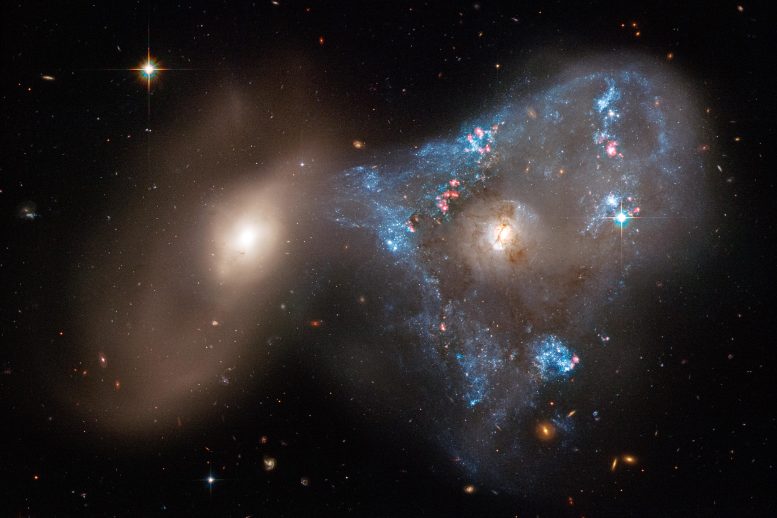
A spectacular head-on collision between two galaxies fueled the unusual triangular-shaped star-birthing frenzy, as captured in a new image from NASA’s Hubble Space Telescope. The interacting galaxy duo is collectively called Arp 143. The pair contains the glittery, distorted, star-forming spiral galaxy NGC 2445 at right, along with its less flashy companion, NGC 2444 at left. Credit: NASA, ESA, STScI, Julianne Dalcanton Center for Computational Astrophysics, Flatiron Inst. / UWashington, Joseph DePasquale (STScI)
Interactions Between These Two Galaxies Is Creating a Tsunami of Starbirth
If you like looking at weirdly shaped galaxies, there’s no better place than the “Arp Catalogue of Peculiar Galaxies.”
Compiled by astronomer Halton Arp in 1966, the catalog is a compendium of 338 oddball interacting galaxies. But Arp didn’t compile the catalogue just to show off galaxies that look strange. He thought these peculiar galaxies were excellent laboratories to study the physical processes that distort normal-looking elliptical and spiral galaxies. He was one of the first to suggest galactic encounters could form stars in bursts.
His view contrasted with those of many astronomers during the 1960s, who wrote off misshapen galaxies as mere oddities. They believed in a “cookie-cutter” universe, that most galaxies were orderly and symmetrical. But Arp believed in a different kind of universe, one filled with violence and birth.
One such Arp galaxy that is exploding with new stars is in this Hubble Space Telescope image of the Arp 143 system. The two galaxies in this system collided head-on, fueling the triangular-shaped burst of star formation. The pair contains the distorted, star-forming spiral galaxy NGC 2445 at right, along with its less flashy companion, NGC 2444 at left.
A spectacular head-on collision between two galaxies fueled an unusual triangular-shaped star-birthing frenzy, as captured in a new image from NASA’s Hubble Space Telescope. Credit: NASA’s Goddard Space Flight Center, Lead Producer: Paul Morris
A spectacular head-on collision between two galaxies fueled the unusual triangular-shaped star-birthing frenzy, as captured in a new image from NASA’s Hubble Space Telescope.
The interacting galaxy duo is collectively called Arp 143. The pair contains the glittery, distorted, star-forming spiral galaxy NGC 2445 at right, along with its less flashy companion, NGC 2444 at left.
Astronomers suggest that the galaxies passed through each other, igniting the uniquely shaped star-formation firestorm in NGC 2445, where thousands of stars are bursting to life on the right-hand side of the image. This galaxy is awash in starbirth because it is rich in gas, the fuel that makes stars. However, it hasn’t yet escaped the gravitational clutches of its partner NGC 2444, shown on the left side of the image. The pair is waging a cosmic tug-of-war, which NGC 2444 appears to be winning. The galaxy has pulled gas from NGC 2445, forming the oddball triangle of newly minted stars.
“Simulations show that head-on collisions between two galaxies is one way of making rings of new stars,” said astronomer Julianne Dalcanton of the Flatiron Institute’s Center for Computational Astrophysics in New York and the University of Washington in Seattle. “Therefore, rings of star formation are not uncommon. However, what’s weird about this system is that it’s a triangle of star formation. Part of the reason for that shape is that these galaxies are still so close to each other and NGC 2444 is still holding on to the other galaxy gravitationally. NGC 2444 may also have an invisible, hot halo of gas that could help to pull NGC 2445’s gas away from its nucleus. So, they’re not completely free of each other yet and their unusual interaction is distorting the ring into this triangle.”
NGC 2444 is also responsible for yanking taffy-like strands of gas from its partner, stoking the streamers of young, blue stars that appear to form a bridge between the two galaxies.
These streamers are among the first in what appears to be a wave of star formation that started on NGC 2445’s outskirts and continued inward. Researchers estimate the streamer stars were born between about 50 million and 100 million years ago. But these infant stars are being left behind as NGC 2445 continues to pull slowly away from NGC 2444.
Stars no older than 1 million to 2 million years are forming closer to the center of NGC 2445. Hubble’s keen sharpness reveals some individual stars. They are the brightest and most massive in the galaxy. Most of the brilliant blue clumps are groupings of stars. The pink blobs are giant, young star clusters still enshrouded in dust and gas.
Although most of the action is happening in NGC 2445, it doesn’t mean the other half of the interacting pair has escaped unscathed. The gravitational tussle has stretched NGC 2444 into an odd shape. The galaxy contains old stars and no new starbirth because it lost its gas long ago, well before this galactic encounter.
“This is a nearby example of the kinds of interactions that happened long ago. It’s a fantastic sandbox to understand star formation and interacting galaxies,” said Elena Sabbi of the Space Telescope Science Institute in Baltimore, Maryland.
The Hubble Space Telescope is a project of international cooperation between NASA and ESA (European Space Agency). NASA’s Goddard Space Flight Center in Greenbelt, Maryland, manages the telescope. The Space Telescope Science Institute (STScI) in Baltimore, Maryland, conducts Hubble science operations. STScI is operated for NASA by the Association of Universities for Research in Astronomy in Washington, D.C.

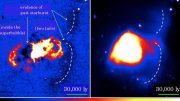

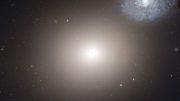
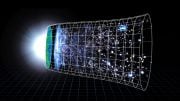
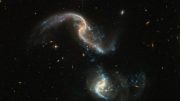

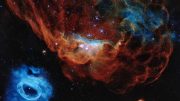

Rotation after the collision and merge increase for both the galaxies previously existed to feed an additional amount.This addition in rotation forms surplus stars.
Rotation of a galaxy is the quantity or property that links this,with other galaxies.This quantity is increased after collision and merge of galaxies than addition of rotations of indivisual galaxy units one to one before collision.This consequence of increase in rotation accounts for the extra stars evolution.
The reason of emergence of specific angle of view or orintation in AGN is due to rotation.Simultaneously,dark matter accumulation with a timè dependent radial density function concentration around a super massive black hole is due to rotation.So,excess number of stars appeared due to increase in amount of rotations of isolate galaxies after collision to merge is confirmed.
Rotation is the property of galaxy that gives orientation to plasma around super massive black hole in AGN.This property of rotation defines the radial density of dark matter as a function of time around the super massive hlack hole.More star formation is possible due to more galaxy link or rotation in case of two or more galaxies’ collision to form unite.
Rotation is the property of galaxy that gives orientation to plasma around super massive black hole in AGN.This property of rotation defines the radial density of dark matter as a function of time around the super massive hlack hole.More star formation is possible due to more galaxy link or rotation in case of two or more galaxies’ collision to form unite.
Details of mathematics is not presented, as matter is practical.But to clarify the concept,this can be noted that number of external galaxies linkage of each galaxy after collision is sum of galaxies linkage of all, present in the collision event.